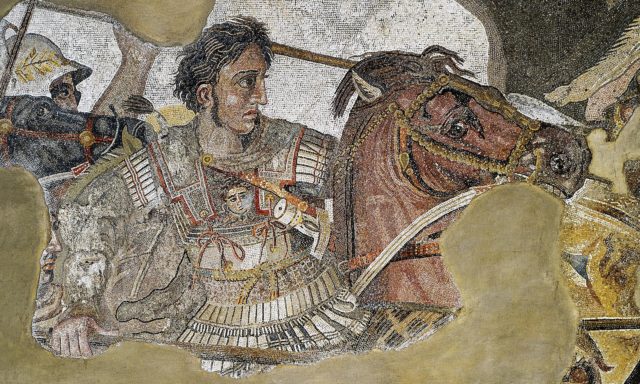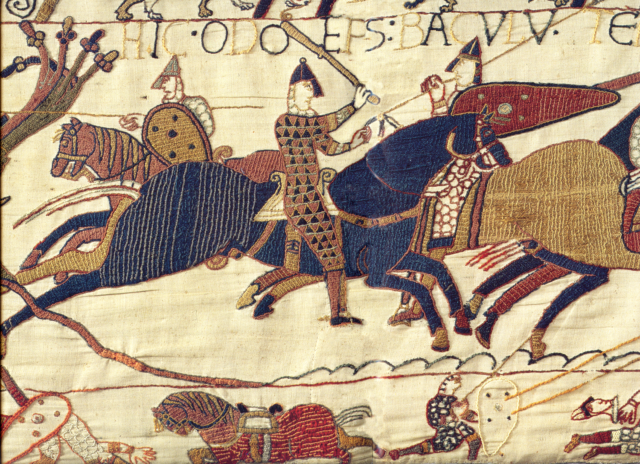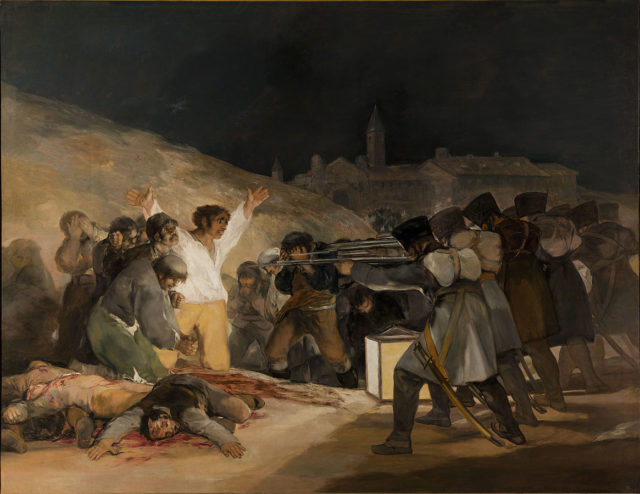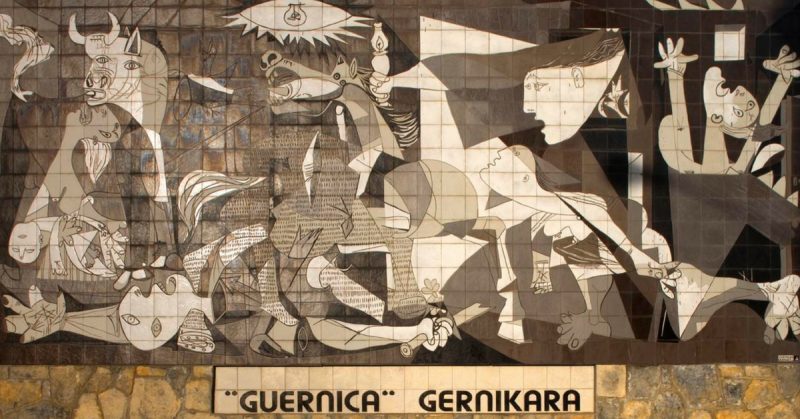With its drama, spectacle, and significance for human life, war has always inspired art. From cave paintings of stone age skirmishes to abstract explorations of the war on terror, they are intimately connected.
Here are four moments in history that inspired great works of art.
Alexander Fights Darius: The Alexander Mosaic
Twice during his career, Alexander the Great faced Darius III, the Achaemenid emperor. Twice he was victorious.
The Achaemenid Empire was one of several to arise in Persia. The dominant power in the Middle East in the 4th century, it asserted authority over parts of Greece and stood in the way of Alexander the Great, King of Macedonia.
Following initial Macedonian successes, Darius chose to lead his army personally. In the fall of 333 BC, he forced Alexander into battle at Issus, after threatening his supply lines. It proved an error, as Alexander outmaneuvered Darius, burst through his lines in a cavalry charge, and chased him from the field.
Two years later, it happened again at Gaugamela. The outnumbered Alexander defeated Darius through superior tactics. Again, he pursued the emperor from the field. Again Darius escaped, only to be murdered by one of his own lieutenants.
The most famous ancient image we have of Alexander commemorates one of those battles, probably Issus. The Alexander Mosaic was a floor mosaic in a Roman villa at Pompeii. Probably a copy of an earlier painting, it was made from over a million tiny colored tiles. Foreshortening and shading add to the drama of the scene, evoking the moment in which, with the battle raging around them, Alexander pursues Darius from the field.

William I Conquers England: The Bayeux Tapestry
In 1066 AD, Duke William of Normandy invaded England. The death earlier that year of Edward the Confessor had left several claimants to the throne, and William was one of them.
On October 14, William faced his only remaining rival, Harold Godwinson, at the Battle of Hastings. Harold’s Anglo-Saxon forces held a hilltop with a strong shield wall. William used archers and cavalry charges to try to break through. They also used feigned flights to draw men out from the shield wall to fight them in the open.
It was a close fought battle. At one point, William was believed to have been killed, and he had to pull up his helmet to reassure his men that he was still alive. In the end, it was Harold who died in the battle, possibly with an arrow in his eye. His forces broke, and the Normans won. William became King of England.
In the 1070s, William’s half-brother Odo, Bishop of Bayeux, commissioned an embroidered depiction of the events. In a style similar to modern comic strips, it depicts the lead-up to the battle and the fighting itself through a series of images. One of the most spectacular European works of art of the period, it is not technically a tapestry, as it is embroidered rather than woven. It is a valuable historical source and provides a wonderful depiction of those events.

Spanish Resistance to Napoleon: The Third of May 1808 by Francisco Goya
In 1807, French forces under Napoleon Bonaparte entered Spain, which was supposedly allied to France. The following year, Napoleon replaced the Spanish King with his brother, removing any illusion that it was not an occupation.
Some Spaniards served the French, but many resisted. Irregular warfare broke out as both civilians and ex-officers formed armed bands to fight back. The word “guerrilla” entered the English language from that period – it means “little war” in Spanish.
The situation created great bitterness and cruel treatment on both sides. French troops executed civilians and burned homes in an attempt to put down resistance. The guerrillas treated the invaders with equal cruelty. Eventually, British and Portuguese troops, working with the guerrillas, slowly drove the French out.
One of the major moments of resistance was an uprising in Madrid on May 2, 1808. Goya’s famous oil painting The Third of May 1808 depicts the fallout from it and was completed six years later. It shows a firing squad of French soldiers massacring a disorganized group of captured civilians, presumably rebels. One victim, in particular, stands out. Brightly lit from below, he stares intensely at his killers, arms flung wide.
It was a painting that broke with traditional depictions of war, both in its style and its content. There was no heroism here, only victims and killers caught up in the act of cruelty.

German Bombers Over Spain: Guernica by Pablo Picasso
130 years later, Spain was the site of another act of military cruelty, this time at the hands of the Germans.
The Spanish civil war was raging. General Franco, leading a coalition of right-wing forces, had launched a coup. It led to war against the left-wing coalition of the Republicans. It was a bitterly fought war, in which 20th-century ideologies mixed with personal loyalties to create a bitter brew.
Hitler used the war as an opportunity to test out German weapons while supporting a potential ally. He lent support to the far-right Franco, primarily in the form of parts of the Luftwaffe, the German air force. It gave the Luftwaffe pilots an opportunity to hone their skills and test their weapons.
On April 26, 1937, they bombed the town of Guernica. It was a Republican stronghold and cultural center of the Republican-leaning Basque people. The town was devastated. With many men away fighting the war, most of the victims were women and children.
Two months later, the Spanish artist Pablo Picasso completed Guernica, an oil-painted mural of the event. It’s disjointed, and abstract images evoke the chaos and carnage of the violence done to the town and its people. It is one of the most famous images in modern art and perhaps the most famous anti-war image ever produced.
Sources:
General Sir John Hackett, ed. (1989), Warfare in the Ancient World
Philip Haythornthwaite (2004), The Peninsular War: The Complete Companion to the Iberian Campaigns 1807-14
